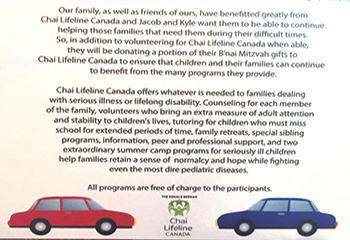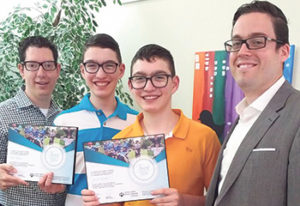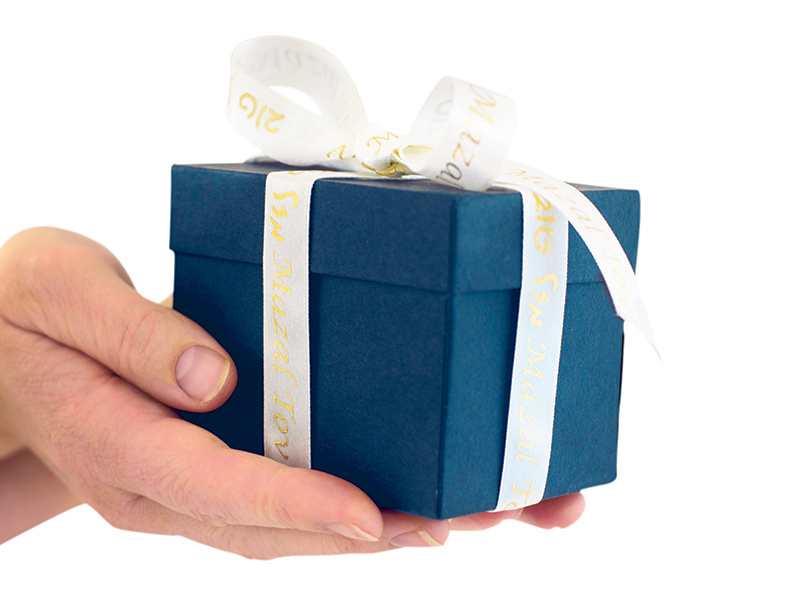But does asking for tzedakah instead of gifts advance a culture of generosity, or is it limited to the community’s privileged pockets?
In 1997 in Edmonton, Sam (not his realname) marked his bar mitzvah the usual way – usual, that is, for the late ’90s.
He read his Torah portion in synagogue, had a party with family and friends, and was the recipient of quite a number of gifts.
“It was mostly cash, some Judaica,” the now 32-year-old recounted over the phone.
He received a total of around $5,000, an amount he deposited, at his mother’s behest, into a savings account, except for the $200 with which he was permitted to buy a Discman.
“It had 20-second skip protection,” noted Sam, who is now a consultant.
After high school, he used the remaining amount to travel to Israel and spent the year living there.
Nearly two decades later, in advance of the joint bar mitzvah of 13-year-old twins Jacob and Kyle Zaldin, their Toronto-based family created a website where guests could RSVP to the event.

The site explained that the boys would be donating a portion of their bar mitzvah gifts to Chai Lifeline Canada, an organization that helps families who have a child living with a serious illness or disability.
On the landing page, beneath several photos of the twins, there’s a blurb outlining the Zaldins’ connection to Chai Lifeline and some of the services the charity offers.
It notes that Jacob and Kyle will be volunteering at Chai Lifeline, and gives guests the option to donate directly to the charity.
At the actual bar mitzvah, each table contained a card noting that the twins would be donating to Chai Lifeline and describing the organization’s activities.
“It was the boys’ idea to do this,” their mother, Michelle Zaldin, said, noting that her daughter, the twins’ younger sister, has mild cerebral palsy and has benefited greatly from Chai Lifeline’s programs.
Zaldin observed that some guests seemed to “put a bit more money into their cheques” knowing that part would go to a charitable cause.
READ: STUDENT DONATES BAT MITZVAH GIFTS TO NEEDY IN ISRAEL

After the bar mitzvah, the twins presented a cheque to Chai Lifeline and received an honorary plaque in return, as well as an invitation to visit the summer camp for kids with terminal illness that their donation helped to support.
Zaldin said that among her sons’ contemporaries, she’s noticed a real trend of children donating part or all of their bar or bat mitzvah money to charity.
“My kids are in day school, so it may be more of a trend in that community. A lot of these kids don’t need anything themselves, so they may be more willing to give,” she said.
Incorporating charitable giving into the experience of becoming a bar or bat mitzvah is not a new practice. Indeed, many day schools and synagogue bar and bat mitzvah classes have long required their students to fundraise for a cause, participate in a social justice project or fulfil a quota of volunteer hours.
But in some circles in Canada’s Jewish community, it seems to have become de rigueur for families to publicize that their child is donating all or part of their gift money to a specific cause, and to incorporate that fact into aspects of the simchah itself, such as the invitations or centrepieces.
But is the trend helping to advance a culture of generosity and anti-materialism among Jewish youth coming of age, or is this practice limited to the community’s more privileged pockets?
Rabbi Daniel Korobkin, spiritual leader of the Orthodox synagogue Beth Avraham Yoseph of Toronto, said close to half of the bar and bat mitzvahs he sees involve a charitable project of some kind. Some choose to donate funds quietly, but more and more, families are announcing that part of their child’s gift money will be given to charity.
READ: A GIVING PLEDGE FOR TORONTO
Often, Rabbi Korobkin observed, the table centrepiece at a bar or bat mitzvah celebration is a basket of foods or goods that guests are informed will be donated to people in need.
Emphasizing tzedakah as part of the process of becoming a bar or bat mitzvah is not new, he said, but he has found that the practice has become “institutionalized” of late.
“It’s become trendy to incorporate tithing – the idea of giving 10 per cent of money one earns or receives to charity – into the bar and bat mitzvah celebration itself, rather than a family deciding privately to donate part of the cheques after the event,” Rabbi Korobkin said.
The Thornhill Jewish community is very diverse, he said, and his congregation encompasses both families who cannot afford to host a kiddush to honour a child’s bar or bat mitzvah and families who mark the milestone by throwing large parties.
Regardless if one is struggling, he said, giving to charity – each to his or her own ability – is an important value in the Orthodox community and an integral part of a bar and bat mitzvah child’s Jewish learning.
“The rules of tzedakah demand that even a poor person who receives charity tithe and give away some of what they receive,” he said.
Invariably, even a child who’s not from an affluent family will receive some bar and bat mitzvah gifts, he said, and the lesson taught to each is to give 10 per cent of that to tzedakah.
“The beauty of this trend is the family doesn’t have to say how much they’re donating. It can be a very small amount,” Rabbi Korobkin stressed.
The obligation to give notwithstanding, is publicizing the mitzvah necessarily sending the right message to bar and bat mitzvah students? What about the value of modesty, and of Jewish philosopher Maimonides’ popular notion of eight levels of charity, in which giving anonymously ranks at a higher level than making it known that one has given tzedakah?
Rabbi Korobkin said he doesn’t see the latter as a significant issue, adding that the trend of announcing one’s contribution actually “provides inspiration to the next bar or bat mitzvah child to [donate]. It creates a sort of a positive contagion.”
Rabbi Aaron Levy, leader of the downtown Toronto spiritual community Makom, acknowledged the possibility that fostering a culture in which publicizing donations of bar and bat mitzvah money “could become ostentatiously competitive.”
However, he stressed that giving to charity is ultimately a “net positive,” adding, “You can say the same thing about people who make significant donations to causes and are acknowledged in a newsletter, or with their name on a plaque or a building. Does that detract from the mitzvah of tzedakah? You could argue that it may not be the ideal form of the mitzvah, but it’s still doing the mitzvah.”
Rabbi Adam Cutler of Beth Tzedec Congregation said Maimonides’ theory can be counterbalanced by the fact that people in the charitable sector are often hesitant about anonymous giving, because when gifts are given with names attached, it provides guidance to others to donate
“So yes, there’s a tension there,” he said.
At the Vancouver Talmud Torah day school, gift-giving among bar and bat mitzvah students has been banned outright, a policy that’s integrated into a year-long course on tikkun olam.
At the beginning of the Grade 7 school year, each family puts $180 into a kitty. Every student then undertakes a project in which he or she extensively researches a specific charity and makes a case to his or her peers to donate money from the kitty, as well as, if possible, additional money to the charity.
READ: AUTISTIC BOY DONATES $28,000 FROM BAR MITZVAH TO VE’AHAVTA
“I think when we first introduced the program, there was disappointment from kids about missing out on the 40 or 50 gifts they could have received from classmates,” said Jennifer Shecter, Talmud Torah’s director of communications and admissions.
“But truthfully, most will still get gifts from relatives and other people. And the practice has become so entrenched that the kids don’t really think about it. They just don’t get gifts from friends.”
Jian Magen is president of Magen Boys Entertainment, a Toronto event production company that’s been providing entertainment at bar and bat mitzvahs and other events for almost 20 years.
He’s noticed that “giving back” has become more prevalent and that bar and bat mitzvah kids are increasingly asking for donations to a charity in lieu of presents.
“A lot more kids seem to understand the importance of philanthropy. That’s refreshing, because sometimes bar and bat mitzvahs get a bad rap for being over the top,” Magen said.
The parties, of course, may still be over the top.
Magen said certain pockets of the city are “still doing the all-out bender,” while others “are looking to scale back and do more of a kids’ party, and then might use the money they saved to take the family to Israel.”
Rabbi Ellen Greenspan of Montreal’s Temple Emanu-El-Beth Sholom, a Reform synagogue, said she thinks asking kids to give a portion of their bar and bat mitzvah money to charity is “a great expectation and one of the responsibilities of being a Jewish adult.”
However, she said she would never tell parents to encourage their children not to receive presents.
“As a parent myself, 10 years ago, I tried to convince my own daughter at her bat mitzvah to ask for donations to charity in lieu of gifts, and she said, ‘No way,’” she chuckled.
ECHOage, a business that started in Toronto and now serves all of North America, is an online service helps families throwing a child’s birthday party or bar and bat mitzvah celebrations co-ordinate with a charity of their choosing. It sends out invitations informing guests that half the money they give the child will go toward a gift and the other half will go to the charity.
The service is free for families but charities are charged a fee to participate.
Co-founder Debbie Zinman said that about 10 per cent of users are families hosting bar and bat mitzvahs, such as a recent bar mitzvah celebration in which a boy raised money for the World Wildlife Foundation.
“The giver gets a tax receipt… It’s win-win-win for moms, for the charity, for the environment because there’s less packaging, and for the kid, who becomes a philanthropist at a young age,” she said, noting that ECHOage will be working on 10,000 birthday parties this coming year.
Toronto social worker Lisa Newman remembers some of the pressures that arose when her three children, now adults, were bar and bat mitzvah age.
“There could be tremendous competitiveness around whose simchah is more elegant or expensive… and my girls suffered… Some little girls had a new dress for every party, while others didn’t. I wasn’t big on buying fancy clothes and I think that’s not in the spirit of a bar and bat mitzvah,” she explained.
Newman, whose eldest grandchild will soon become a bar mitzvah, suggested that the recent trend of integrating charity into simchahs might serve as an antidote to some of the pressures.
“If the charity donation component dilutes some of that – especially if it includes the child doing tzedakah or useful tasks – all the better,” she said.
She also had no issue with the concept of publicizing donations.
READ: BOY’S BAR MITZVAH MONEY GOES TO GUATEMALAN SCHOOLKIDS
“I see it as an extension of what we’ve always done in the Jewish community. For example, when someone dies, you make a donation. You don’t say how much you gave, so it’s not competitive in that way.”
Rabbi Korobkin ultimately agreed that emphasis on charity could provide a counterweight to the materialist aspects of more elaborate bar and bat mitzvahs.
“There’s both so much consumerism and so much need within the Jewish community. The fact that you can go to a bar and bat mitzvah with a lavish buffet, a photo booth, etc., and then sit at the table and see a centrepiece that shows the family’s taken tremendous care to raise funds and awareness for a charitable cause, to share their simchah with those less fortunate –that is a beautiful thing,” he said.
